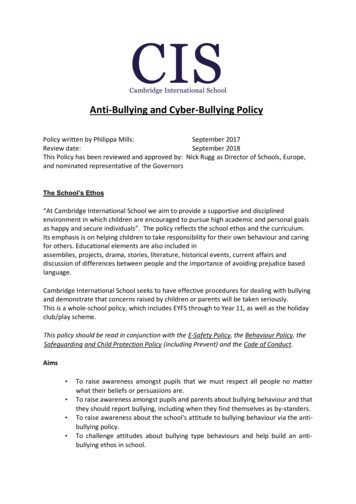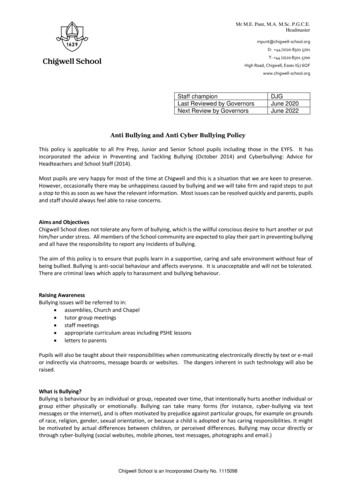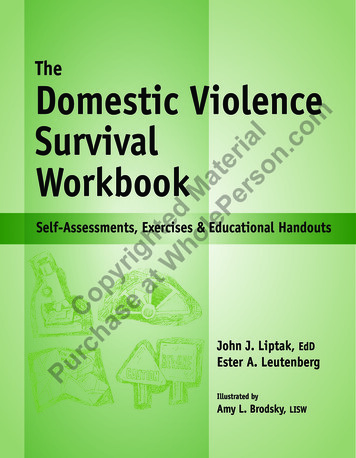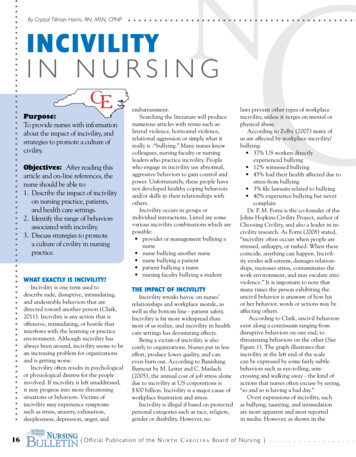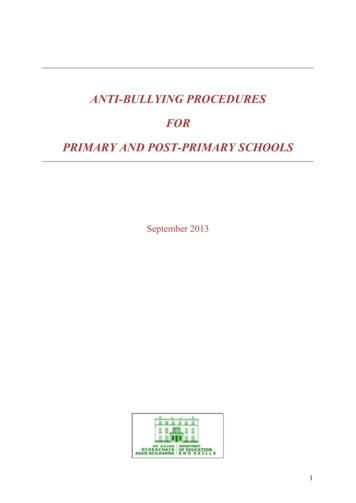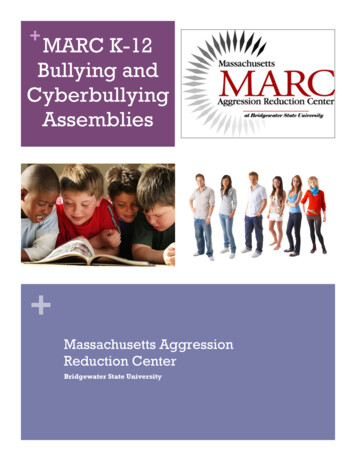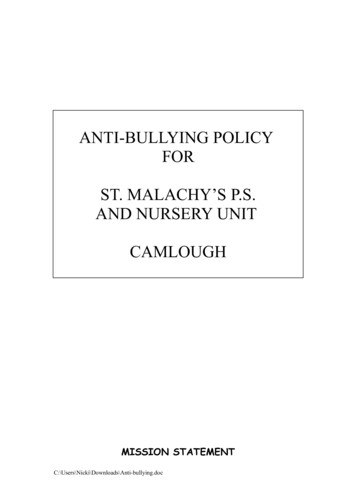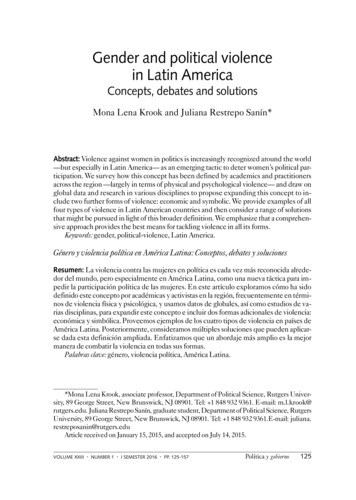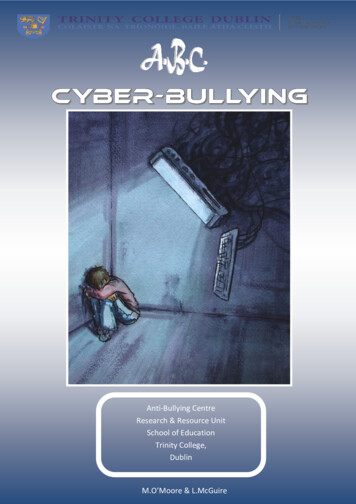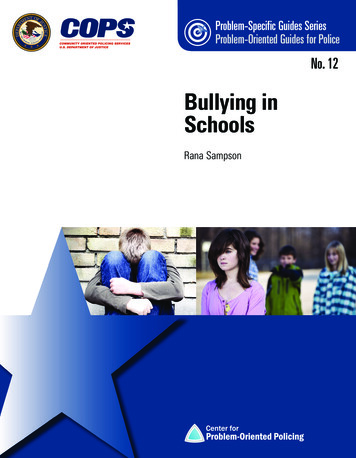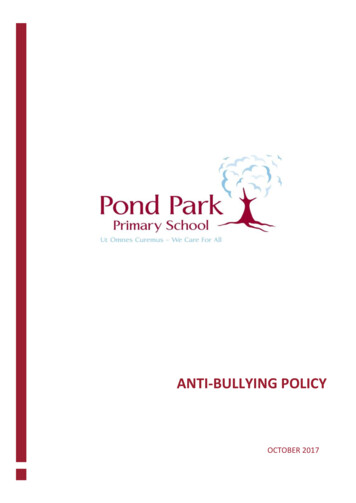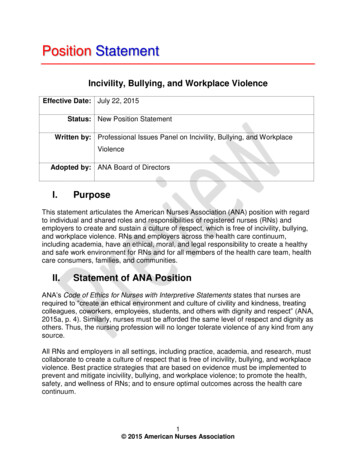
Transcription
Position StatementIncivility, Bullying, and Workplace ViolenceEffective Date: July 22, 2015Status: New Position StatementWritten by: Professional Issues Panel on Incivility, Bullying, and WorkplaceViolenceAdopted by: ANA Board of DirectorsI.PurposeThis statement articulates the American Nurses Association (ANA) position with regardto individual and shared roles and responsibilities of registered nurses (RNs) andemployers to create and sustain a culture of respect, which is free of incivility, bullying,and workplace violence. RNs and employers across the health care continuum,including academia, have an ethical, moral, and legal responsibility to create a healthyand safe work environment for RNs and for all members of the health care team, healthcare consumers, families, and communities.II.Statement of ANA PositionANA’s Code of Ethics for Nurses with Interpretive Statements states that nurses arerequired to “create an ethical environment and culture of civility and kindness, treatingcolleagues, coworkers, employees, students, and others with dignity and respect” (ANA,2015a, p. 4). Similarly, nurses must be afforded the same level of respect and dignity asothers. Thus, the nursing profession will no longer tolerate violence of any kind from anysource.All RNs and employers in all settings, including practice, academia, and research, mustcollaborate to create a culture of respect that is free of incivility, bullying, and workplaceviolence. Best practice strategies that are based on evidence must be implemented toprevent and mitigate incivility, bullying, and workplace violence; to promote the health,safety, and wellness of RNs; and to ensure optimal outcomes across the health carecontinuum.1 2015 American Nurses Association
This position statement, although written specifically for RNs and employers, is alsorelevant to other health care professionals and stakeholders who collaborate to createand sustain a safe and healthy interprofessional work environment. Stakeholders whohave a relationship with the worksite also have a responsibility to address incivility,bullying, and workplace violence.III.BackgroundIncivility, bullying, and workplace violence are part of a larger complex phenomenon,which includes a “constellation of harmful actions taken and those not taken” in theworkplace (Saltzberg, 2011, p. 229). The term “actions taken and not taken” provides anoverarching framework that includes using explicit displays of uncivil or threatening acts,as well as failing to take action when action is warranted or required to address incivility,bullying, or violence in the workplace.Some harmful actions may be more overt, such as making demeaning comments orusing intimidation to undermine a coworker. Other forms of incivility and bullying can bemore covert, such as failing to intervene or withholding vital information when actionsare clearly indicated and needed for work to be done in a safe manner. Those actionstaken and actions not taken currently occur along a continuum and range from thesubtle and covert to the overt and from less to more harmful (Clark, 2013a; Einarsen,Hoel, Zapf, & Cooper, 2011; World Health Organization, 2015).Unfortunately, the full range of actions related to this complex phenomenon hasnegatively impacted RNs globally and, in some cases, has been accepted and culturallycondoned. For nearly a century, some form of incivility, bullying, or violence hastouched far too many members of the nursing profession. It affects every nursingspecialty, occurs in virtually every practice and academic setting, and extends into everyeducational and organizational level of the profession (Hader, 2008; McKenna, Smith,Poole, & Cloverdale, 2003).It is important to first acknowledge the existence of harmful actions taken and actionsnot taken in the workplace in order to eliminate them. Those who experience workplaceincivility, bullying, or violence know firsthand its harmful, detrimental effects, especiallywhen their experiences are not taken seriously by coworkers and supervisors. Thoseharmful effects have been described as additive in that they accumulate burden and canbecome synergistic. Moreover, their combined effects can go beyond what each can doalone. Bullying and other harmful actions can be “surrounded by a ‘culture of silence,’fears of retaliation, and the perception that ‘nothing’ will change” (Vessey, DeMarco, &DiFazio, 2011, p. 142).Any form of workplace violence puts the nursing profession and nursing’s contract withsociety in jeopardy (Saltzberg, 2011). Those who witness workplace violence and donot acknowledge it, who choose to ignore it, or who fail to report it (Hutchinson, 2009)are in fact perpetuating it. Thus, organizations that fail to address it through formalsystems are indirectly promoting it (The Joint Commission, 2008). Refusal to engage in2 2015 American Nurses Association
addressing what has become—in some workplaces—accepted norms surroundingworkplace violence is no longer an option because “not all norms or values are moralnorms or values” (Colby et al., 1987). Taking action is a moral stance consistent withthe ANA Code of Ethics for Nurses with Interpretive Statements (2015a). The entirenursing profession must actively drive a cultural change to end incivility, bullying, andviolence in the workplace.IncivilityRNs and their employers should acknowledge the various forms of workplace violence,as well as the extent that each occurs in their work setting. By differentiating the variousforms of harmful actions taken and of actions not taken, the nursing profession canfocus its collective wisdom and experience on leading the campaign to create a cultureof respect, safety, and effective interprofessional communication.Incivility can take the form of rude and discourteous actions, of gossiping and spreadingrumors, and of refusing to assist a coworker. All of those are an affront to the dignity ofa coworker and violate professional standards of respect. Such actions may alsoinclude name-calling, using a condescending tone, and expressing public criticism(Andersson & Pearson, 1999; Read & Spence Laschinger, 2013). The negative impactof incivility can be significant and far-reaching and can affect not only the target(s)themselves, but also the bystanders, peers, stakeholders, and organizations. If leftunaddressed, it may progress in some cases into threatening situations or violence(Clark, 2013a).Oftentimes, incivility is not directed at any specific person or persons. However, it mayperpetuate or become a precursor to bullying and workplace violence; therefore, itcannot be characterized as innocuous or inconsequential (Pearson, Andersson, &Porath, 2005). Studies have shown that incivility experienced through e-mail or otheronline forums had similar effects to face-to-face incivility (Clark, 2013b; Clark, Ahten, &Werth, 2012; Clark, Werth, & Ahten, 2012; Giumetti et al., 2013).BullyingBullying is repeated, unwanted harmful actions intended to humiliate, offend, and causedistress in the recipient. Bullying actions include those that harm, undermine, anddegrade. Actions may include, but are not limited to, hostile remarks, verbal attacks,threats, taunts, intimidation, and withholding of support (McNamara, 2012). Suchactions occur with greater frequency and intensity than do those actions described asincivility. Bullying actions represent serious safety and health issues, and they cancause lasting physical and psychological difficulties for targets (Washington StateDepartment of Labor and Industries, Safety and Health Assessment and Research forPrevention Program, 2011).Bullying often involves an abuse or misuse of power, creates feelings ofdefenselessness and injustice in the target, and undermines an individual’s inherent3 2015 American Nurses Association
right to dignity. Bullying may be directed from the top down (employers againstemployees), from the bottom up (employees against employers), or horizontally(employees against employees). Top-down bullying from organizational leaders allowsbullying to become an accepted and condoned workplace norm (Deans, 2004a; RoyalCollege of Nursing, 2002; Vessey, DeMarco, & DiFazio, 2011). Hutchinson, Wilkes,Jackson, and Vickers (2010) used structural equation modeling to test a model ofbullying. Their survey data from 370 nurses revealed specific organizationalcharacteristics, including misuse of authority, certain policies and procedures,organizational tolerance, and informal alliances, as the critical antecedents to bullyingand its frequency.RNs and employers must also be cognizant of workplace mobbing as a collective formof bullying and as an expression of aggression aimed at ostracizing, marginalizing, orexpelling an individual from a group (Bowling & Beehr, 2006; Galen & Underwood,1997; Harper, 2013). As Griffin and Clark (2014) state, workplace mobbing occurs when“more than one person commits egregious acts to control, harm, and eliminate atargeted individual” (p. 536). Mobbing is linked to physical, psychological, social, andemotional damage, and it can have devastating economic consequences as thetargeted individuals fight to keep their job and career (DiRosa et al, 2009; Hutchinson,Vickers, Jackson, & Wilkes, 2006; Monteleone et al., 2009; Vessey, DeMarco, Gaffney,& Budin, 2009).When investigating experiences of workplace mobbing and comparing thoseexperiences with indicators on various scales, Balducci, Alfano, and Fraccaroli (2009)found positive and significant correlations between the frequency of exposure tomobbing and the appearance of various indicators, including posttraumatic stress. Theauthors found that the frequency of exposure to mobbing predicted suicidal ideation andbehavior.In 1990, Leymann described workplace mobbing as the adult form of bullying. It ischaracterized by employees “ganging up” on a target employee and subjecting thatindividual to psychological harassment that may result in severe psychological andoccupational consequences. In some cases, targets of workplace mobbing may beexceptional employees. For example, Westhues (2004) suggested that mobbing amongfaculty members in academic workplaces may be related to envy of excellence and tojealousy associated with the achievements of others. Mobbing may thus occur in suchworkplaces in an attempt to maintain group mediocrity and compliance with the statusquo, so that the high performer is targeted to keep that person in line with prevailingworkplace norms.Workplace ViolenceWorkplace violence consists of physically and psychologically damaging actions thatoccur in the workplace or while on duty (National Institute for Occupational Safety andHealth [NIOSH], 2002). The Bureau of Labor Statistics releases an annual report aboutinjuries and illnesses resulting in time away from work in the United States. In the health4 2015 American Nurses Association
care and social assistance sector, 13% of days away from work were the result ofviolence in 2013, and this rate has increased in recent years (U.S. Department of Labor[DOL], Bureau of Labor Statistics, 2014). According to a recent ANA survey of 3,765registered nurses and nursing students, 43% of respondents have been verbally and/orphysically threatened by a patient or family member of a patient. Additionally, 24% ofrespondents have been physically assaulted by a patient or family member of a patientwhile at work (ANA & LCWA Research Group, 2014).Workplace violence is referred to by some as endemic, which, from a public healthperspective, means it is commonly found in certain settings (Lipscomb & London, 2015).Such settings include emergency departments, psychiatric hospitals, nursing homes,long-term care facilities, and others. Hodgson et al., (2004) describe how employeeswho float from one unit to another experience assault three times more often than dopermanent employees. Wolf, Delao, and Perhats (2014) provide evidence of theprevailing attitude that workplace violence is a culturally accepted and expected part ofone’s occupation. Oftentimes, patient safety is given priority over employee safety,when in fact both are integral to quality and safe care (Lipscomb & London, 2015).Workplace violence can lead to emotional distress, temporary or permanent injury, oreven death (Tarkan, 2008). Examples of workplace violence include direct physicalassaults (with or without weapons), written or verbal threats, physical or verbalharassment, and homicide (Occupational Safety and Health Administration, 2015).NIOSH classifies workplace violence into four basic types. Types II and III are the mostcommon in the healthcare industry. (Types I and IV are not addressed within thisposition statement.) Type I involves “criminal intent.” In this type of workplace violence, “individualswith criminal intent have no relationship to the business or its employees.” Type II involves a customer, client, or patient. In this type, an “individual has arelationship with the business and becomes violent while receiving services.” Type III violence involves a “worker-on-worker” relationship and includes“employees who attack or threaten another employee.” Type IV violence involves personal relationships. It includes “individuals whohave interpersonal relationships with the intended target but no relationship tothe business” (Iowa Prevention Research Center, 2001; NIOSH, 2006, 2013).Detrimental Effects to the Nursing ProfessionAn overview of relevant literature indicates that incivility, bullying, and workplaceviolence are concerns for the nursing profession, healthcare field, and beyond (Spector,Zhou, & Che, 2013). Kaplan, Mestel, and Feldman (2010) suggest that nurses ignore ortolerate incivility and bullying because of fear or lack of knowledge. However, incivilityand bullying are also reasons nurses leave or plan to leave the profession (Johnson &Rea, 2009; Simons, 2008; Vessey, DeMarco, & DiFazio, 2010). Other negative effectsinclude decreased job satisfaction, reduced organizational commitment, decreasedpersonal health, and added direct and indirect costs to employers and RNs (Rodwell,5 2015 American Nurses Association
Brunetto, Demir, Shacklock, & Farr-Wharton, 2014; Smith, Andrusyszyn, & SpenceLaschinger, 2010).Financial RamificationsDecreased productivity can occur following incidences of incivility, bullying, or workplaceviolence. Employee retention can also become more difficult to maintain. Yet the totalfinancial cost of such actions is very difficult to calculate (Berry, Gillespie, Gates, &Schafer, 2012; Chapman, Styles, Perry, & Combs, 2010; D’Ambra & Andrews, 2014;Edward, Ousey, Warelow, & Lui, 2014; Gates, Gillespie, & Succop, 2011; Hegney,Tuckett, Parker, & Eley, 2010; Spence Laschinger, 2014). According to one study, lostproductivity related to workplace incivility was calculated at 11,581 per nurse annually(Lewis & Malecha, 2011).Another study of a U.S. hospital employing 5,000 nurses estimated the cost ofworkplace violence treatment at 94,156 annually. This amount included 78,924 fortreatment and 15,232 for indemnity for the 2.1% of the hospital’s nurses that reportedinjuries (Speroni, Fitch, Dawson, Dugan, & Atherton, 2014).The costs of incivility increase when one takes into account the expenses associatedwith supervising the uncivil employee; managing the situation; consulting with attorneys;interviewing witnesses; and recruiting, hiring, and training new employees (Griffin &Clark, 2014; Lipscomb & London, 2015; Pearson & Porath, 2009, 2013).RN Health, Patient Safety, and Career ConsequencesIncivility, bullying, and workplace violence harm a person’s intrinsic sense of self-worthand self-confidence, which may result in physical symptoms such as headaches,interrupted sleep, and intestinal problems. Those actions may also be associated withpsychological conditions, including heightened levels of psychological stress, anxiety,irritability, and depressive symptoms (Clark, 2013a; Demir & Rodwell, 2012; Gates etal., 2011; Gillespie, Gates, & Berry, 2013; Magnavita, 2014; Nicholson & Griffin, 2014;Stecker & Stecker, 2014; Wing, Regan & Spence Laschinger, 2015). Some report thatthis heightened stress may advance to the level of posttraumatic stress disorder(Gillespie, Bresler, Gates, & Succop, 2013) or depression (Gullander et al., 2014). Sucheffects may impair clinical judgment to the extent that nurse performance is affected.For example, the Institute for Safe Medication Practices (2009) examined the impactthat intimidation of nurses had on medication errors.In the subsample, 7% of RNs stated that intimidation had led to a medication error.Other studies report an increase in errors related to patient safety (Sofield & Salmond,2003) and to increased incidence in patient falls, delayed medication administration,and medication errors (Roche, Diers, Duffield, & Catling-Paull, 2010). If confidence andcompetence decrease as a result of incivility, bullying, and workplace violence, thisresult can adversely affect the quality of patient care and care outcomes (Deans, 2004b;Leivers, 2004).Incivility, bullying, and workplace violence also occur in academic settings, thusaffecting students, faculty members, and all people in the campus community.6 2015 American Nurses Association
Numerous studies have documented the existence of harmful actions taken and nottaken in academic settings, as well as their consequences (Clark, 2013b; Davis, 2014;Saltzberg, 2011). One such consequence that has major implications for (a) the futureof the nursing profession, (b) the ability to honor nursing’s contract with society, and (c)the ability to attract new nurses to the profession, is faculty intent to leave academia at atime when the United States is facing unprecedented projected increases in demand fornurses (DOL, Bureau of Labor Statistics, 2012).Documents describing a shortage of faculty refer to academic institutions’ claims offinancial and salary issues, of a shortage of doctoral-level faculty, of a shortage offaculty members who are willing and able to teach in clinical settings, of an increasefaculty age and retirement, and of a claim that the pool of qualified faculty is too small(American Association of Colleges of Nursing, 2015).Further study is needed on (a) how faculty, including those that are new or areperceived by faculty peers as highly accomplished, are treated within the halls ofacademe by administrators, faculty peers, and students, and (b) how such treatmentcontributes to the loss of qualified faculty members and to the detrimental effects thatthis loss has on nurses’ lives and careers (Clark, 2013b; Davis, 2014).A Culture of RespectRelationships marred by incivility and bullying can contribute to unhealthy workenvironments that ultimately have a negative impact on the quality and safety of caredelivered (American Association of Critical-Care Nurses, 2005). The establishment ofpositive, respectful relationships is crucial to preventing incivility, bullying, andworkplace violence.Several foundational documents support the need for civility and a culture of respectthat must be continuously demonstrated by nurses in all areas of nursing education andpractice. For example, “Essential VIII: Professionalism and Professional Values”described by the American Association of Colleges of Nursing (AACN, 2008)underscores the importance of nurses being accountable and responsible for theirindividual actions and of ensuring that civility underlies professionalism.Similarly, Provision 1.5 of the ANA Code of Ethics (2015a) requires nurses to treatcolleagues, students, and health care consumers with dignity and respect. It also statesthat any form of harassment, disrespect, or threatening action will not be tolerated. Inaddition, an Institute of Medicine (2010) report recommends empowering nurses toparticipate in collaborative efforts to improve work environments and health caresystems.Respectful relationships in which each person is re
online forums had similar effects to face-to-face incivility (Clark, 2013b; Clark, Ahten, & Werth, 2012; Clark, Werth, & Ahten, 2012; Giumetti et al., 2013). Bullying Bullying is repeated, unwanted harmful actions intended to humiliate, offend, and cause distress in the recipient. Bullying
